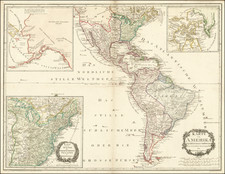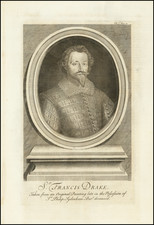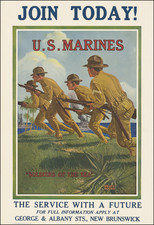John Binns's Allegorical Engraving of the Declaration of Independence
With Portraits of Washington, Jefferson, and Hancock
John Binns's famous engraving of the Declaration of Independence, one of the earliest faithful facsimiles of the document, and arguably the most beautiful early effort to present a tasteful, patriotic print incorporating the manuscript text of the Declaration. Binns' print has detailed allegorical seals of the thirteen original states elegantly arranged as an oval-shaped frame surrounding the manuscript facsimile of the Declaration text. Fine stipple engraved medallion portraits of founding fathers George Washington, John Hancock, and Thomas Jefferson crown the top of the Declaration facsimile. A profusion of symbolic illustrations completes the design, including an eagle with shield, olive branch, and arrows holding a ribbon streamer reading "E Pluribus Unum."
This engraving stands as an apt visual manifestation of a resurgent patriotism sparked by the War of 1812. As many of the original signers were aging and dying, Americans began to properly revere the famous document that declared the nation's independence nearly forty years earlier. In the nation's first few decades the Declaration itself was available for viewing only to a privileged few, mainly those with connections with the Department of State. As interest in the historical document increased, so did concerns about preserving the national relic, thus setting the stage for the demand of a well-made facsimile edition.
John Binns
John Binns, an Irish-born Philadelphia journalist and publisher of the Democratic Press, was one of the first to realize the potential market for a "splendid and correct copy of the Declaration of Independence, with facsimiles of all the signatures, the whole to be encircled with the arms of the thirteen States and of the United States" (as Binns described in his original solicitation for subscribers). Though Binns promised delivery in one year, the enormity of the project delayed publication until 1819, by which time a competitor, Benjamin Owen Tyler, had already rushed a less elaborate facsimile into production. Though Tyler issued his version first, Binns' extraordinary attention to detail clearly overshadowed his competitor's efforts. Binns originally offered his version of the Declaration for $10 ($13 colored), a steep, if entirely justified price given the cost and painstaking labor required of the production.
To create his engraving, Binns requested a copy of the Declaration of Independence, which was then in the custody of the Department of State. Through the offices of Senator Jonathan Roberts of Pennsylvania, Secretary of State James Monroe complied with Binns' request and a copy of the Declaration was provided. Binns later asked the State Department to send him impressions of the coat of arms of the United States and a certificate the arms was, in fact, accurate. Finally, he sent letters to various states asking for impressions and descriptions of their coats of arms, with some slow responses contributing to the delay in getting the print to market.
An engraved caption along the bottom of the sheet presents the endorsement of Secretary of State John Quincy Adams, who attests to the facsimile's accuracy:
Department of State, 19th, April 1819. I certify, that this is a Correct copy of the original Declaration of Independence, deposited at this Department; and that I have compared all the signatures with those of the original, and have found them Exact Imitations.
A slightly undulating caption in smaller type reads:
Originally designed by John Binns. Ornamental part drawn by Geo. Bridport. Arms of the United States, and the thirteen states, drawn from Official Documents, by Thos. Sully. Portrait of Genl. Washington, Painted in 1795 by Stuart. Portrait of Thomas Jefferson, Painted in 1816 by Otis. Portrait of John Hancock, Painted in 1765 by Copley. Ornamental part, Arms of the United States, and the Thirteen States, engraved by Geo. Murray. The writing designed and engraved by C. H. Parker. Portraits engraved by J. B. Longacre. Printed by James Porter.
The copyright line at the foot of the sheet is for John Binns, dated November 4, 1818.
Summary
This version of the Declaration of Independence serves as an important historical document, reflecting the nation's evolving self-conception and the increasing veneration of its foundational principles. The ornate design, with its focus on national symbols and leaders, underscores the pride and unity fostered among the citizens during this period.
Rarity
Nice examples of Binns's Declaration have been steadily increasing in value. A hand-colored version fetched $40,000 at auction in 2022.










![[ US-Mexico Border Survey: General Order From the President of the United States Directing William H. Emory to lead the US-Mexico Boundary Survey ]](https://storage.googleapis.com/raremaps/img/small/101837.jpg)

![(California Photographs) [Group of 4 photographs of John H. Boden of Haywards, California, custom house broker in San Francisco]](https://storage.googleapis.com/raremaps/img/small/93197.jpg)
![(Mississippi Bubble) Kermis Wind-Kraamer En Grossier [Fair of the wholesale wind-pedlar.]](https://storage.googleapis.com/raremaps/img/small/95945.jpg)
